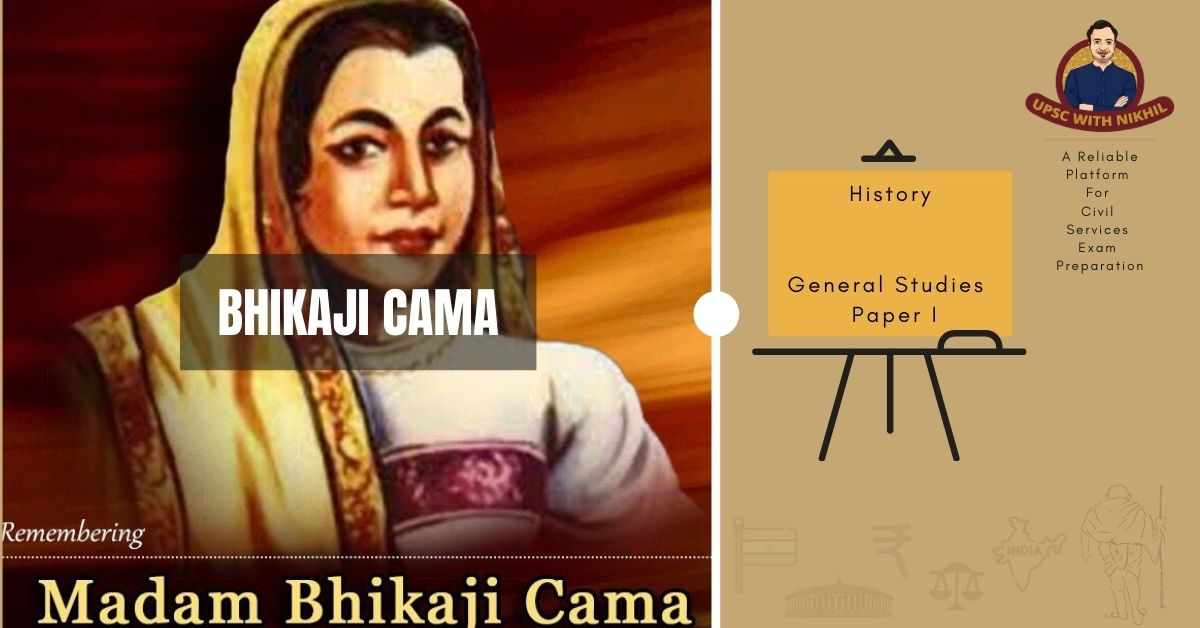Bhikaiji Cama
Bhikaiji Rustom Cama, also known as Madame Cama, was an independence activist and advocate for women’s rights who had the unique distinction of unfurling the first version of the Indian national flag—a tricolour of green, saffron, and red stripes at the International Socialist Congress held at Stuttgart, Germany, in 1907. She played a crucial role in the Indian freedom struggle abroad and was known as the Mother of the Indian Revolution.
• BhikaijiCama was born to Sorabji and Jaijibai Patel on 24th September 1861 at Bombay. She belonged to an affluent Gujarati-speaking Parsi family.
• She attended the Alexandra Native Girl’s English Institution and was said to be a diligent student. In 1885, she was married to Rustom Cama, a pro-British lawyer. Her husband’s loyal attitude towards the British and her own nationalist feelings led to an unhappy marriage.
• Madame Cama’s life changed in October 1896 when a terrible famine hit the Bombay Presidency. Thereafter, the region was also hit by an episode of the bubonic plague. Madame Cama plunged herself into social work and started providing care and relief to those affected. Unfortunately, she herself caught the dreaded disease but luckily survived. However, her health was adversely affected as a result of it. She was sent to London to recuperate.
• In London, she came in touch with several Indian independence activists such as Shyamji Krishna Varma, DadabhaiNaoroji and Singh Rewabhai Rana. She started working as Naoroji’s private secretary.
• She was to return to India but received a message from Britain which said that she would have to sign an undertaking that she would not take part in nationalist activities. Madame Cama refused to sign any such undertaking and so could not return to India.
• She went to Paris instead. There, along with Rana and Munchershah Burjorji Godrej, she co-founded the ‘Paris Indian Society’.

• She also authored, published and distributed revolutionary material from Paris. When the British banned the ‘VandeMataram’, she composed the ‘BandeMataram’. She also wrote ‘Madan’s Talwa’r in reaction to the execution of Madan Lal Dhingra.
• A remarkable event took place on 22nd August 1907. The ‘Socialist Congress’ was taking place at Stuttgart in Germany. Madame Cama attended it and informed people of the terrible famine that had struck India and caused so many avoidable deaths. She also appealed for equality, human rights and autonomy from Britain. She also unfurled the ‘Flag of Indian Independence’ thus becoming the first person to hoist India’s flag on foreign soil.
• Her Words – ‘This is the flag of independent India. I appeal to all gentlemen to stand and salute the Flag’.
• This flag, which was a modification of the ‘Calcutta Flag’ was designed by Madame Cama and Shyamji Krishna Varma.
• In the flag, the top green stripe had eight blooming lotuses representing pre-independence India’s eight provinces. BandeMataram was written across the central saffron stripe in Hindi. On the bottom red stripe, a half moon was on the right and the rising sun on the left, indicating the Hindu and Muslim faith. This flag became one of the models out of which the present Indian National Flag was designed.
• After the 1907 conference in Stuttgart, Camatraveled abroad on an extended lecture tour to mobilize public opinion against British rule in India, especially among expatriate Indians; she also spoke in favour of women’s rights.
• When rumours began that she would be deported from England, she moved in 1909 to Paris, where her home became a headquarters for those agitating for Indian independence. She helped Har Dayal launch his revolutionary paper BandeMataram, copies of which were smuggled into India from London. For three years during World War I, after Great Britain and France became allies, the French authorities interned her for her anti-British activities.
• For her support to revolutionary activities, the British government asked the French government for her extradition, but was refused.
• Cama remained in exile in Europe until 1935, when, gravely ill and paralysed by a stroke that she had suffered earlier that year, she petitioned the British government to be allowed to return home. Knowing that she was not in a condition to participate in the freedom struggle, she was granted permission to return to India after 33 long years.
• In November 1935, 74 year old BHIKAIJI finally returned to Mumbai, but did not live for long. Having fulfilled her desire of seeing her motherland once again, she breathed her last nine months later on August 13 1936. She had bequeathed most of her personal assets to the Avabai Petit Orphanage for girls.
• On 26 January 1962, India’s 11th Republic Day, the Indian Posts and Telegraphs Department issued a commemorative stamp in her honour.
• In 1997, the Indian Coast Guard also commissioned a Priyadarshini-class fast patrol vessel named the ICGS BHIKAIJI Cama.
• An unsung name among the stalwarts of Indian Independence Struggle, Madam BHIKAIJI Cama’s conviction, courage and integrity took the message of Indian freedom struggle to the world with a force and clarity it had never had before.
• The flag which she unfurled at Stuttgart was smuggled into India by other independence activists. It is displayed at the Maratha and Kesari Library in Pune to this day.
Do not forget the important role our women play in building a nation.
-BHIKAIJI CAMA


